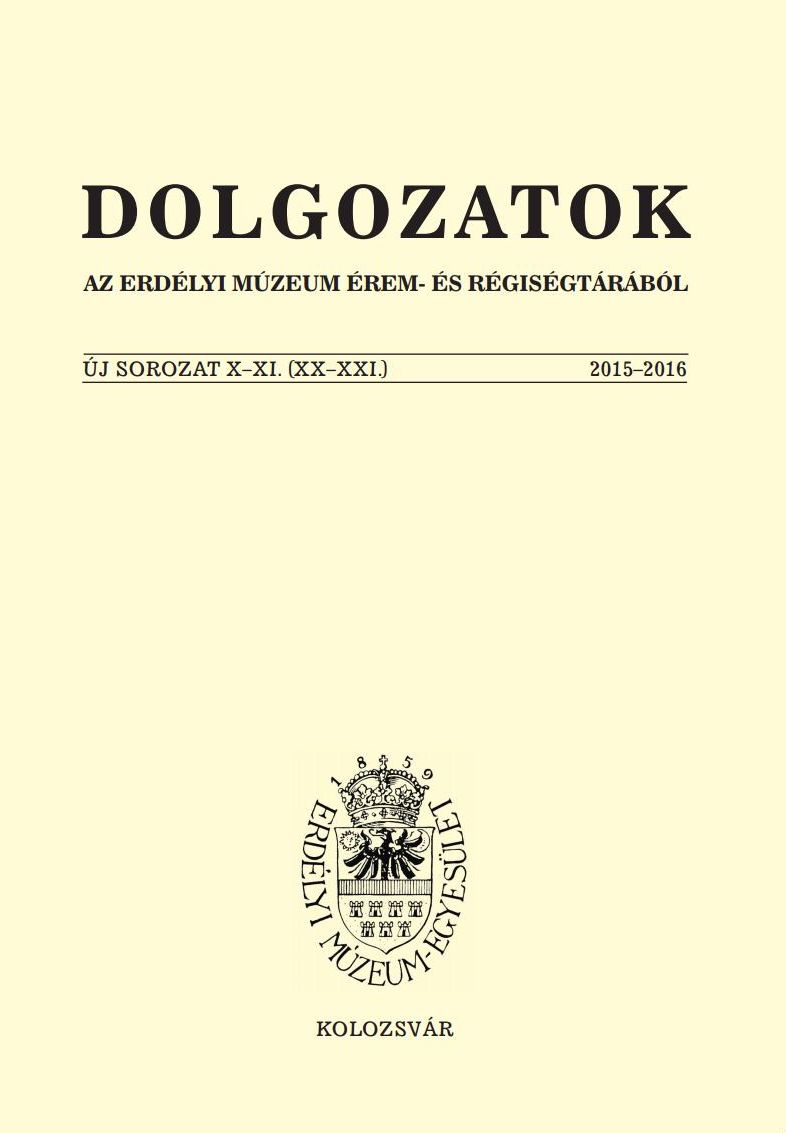Szekér- és kerékmodellek a középső bronzkori Nagykároly-Bobáld tellről
Wagon models from the Middle Bronze Age Carei-Bobald tell
Author(s): Zsolt Molnár, Zoltán KatóczSubject(s): Archaeology
Published by: Erdélyi Múzeum-Egyesület
Keywords: wagon models; wheel models; tell; Middle Bronze Age; Northwestern Transylvania
Summary/Abstract: The carriage and wheel models made of burnt clay are common findings in the Carpatian Basin of the Bronze Age. Following their appearance in the Late Copper Age, statuettes of presumably life-size carriages were found with other materials in a high number. The number of carriage and wheel models found in tells of the Middle Bronze Age is also high. According to the Hungarian Encyclopedia of Ethnology a carriage is a light, four-wheeled vehicle pulled by a horse, while a cart was used to transport heavy cargo and it was usually pulled by horses or oxen. Carriages were built similar to carts, with the difference of being lighter, with more delicate features. Four-wheeled vehicles are classified firstly by the build of their under-structure and the shape and number of their poles, but having or not having the bar connecting the front and the back of the carriage is also general criteria. In the following we will use the two expressions as synonyms. The functionality of carriage models is questioned to this day. Academic resources express opinions that the statuettes made of clay could be children’s toys, items symbolizing economic wellbeing, or objects used for rituals. The carriage models found in the Carpatian Basin are mainly thought to be cultic objects (for the cult of the sun or death) and are speculated to be part of home altars as well. Newly published articles raise a few questions about the commercial significance of carriages and their role in economy as well as their geographical location and their role in rituals. Nevertheless, a four-wheeled vehicle making transport easier would be classified as revolutionary in the Prehistory, and it surely had a significant role in the economy of the Bronze Age, as well as cultural representation and rituals. After analyzing clay models of vehicles of the period by shape and style it’s statable that we’re talking about a type of object that had a symbolic value for a significant amount of time. The shape, structure and similarities in decoration show a unique way of designing and constructing carriages that spread across the Carpathian Basin. The carriage models that have a considerable distance between the places they were found were presumably means of visual communication of general thoughts in the Middle Bronze Age. The statuettes of the four-wheeled carriages are means of preserving physical symbolic information. The inspected objects must have had a big role in creating and preserving the world view and collective memory of communities in the Middle Bronze Age. The ordinary and special material world plays a big part in the collective memory of a community, suggests the role of the individual and the group in the community, remind the important events of the community and the information possessed by the community known as the common knowledge. Not only is it an element that forms identity, but with the help of the common knowledge it ensures the continuity of the community’s self image. The ornamentation on the side of the carriage models can show, apart from the general aesthetic preferences of the period, the existence of so-called festive carriages with symbolic decorations used for public rituals in the community. The different forms of public rituals in the community are known as events that gave multi-sensory experience of variant complexity and were general ways of organising the community. Our study is analyzing the nine carriage and forty-eight wheel models found in Carei- Bobáld, north-west of Transylvania. Our analysis mainly focuses on the finding circumstances and tipochronological characteristics of the objects. We can state based off the finding circumstances of the carriage and wheel models that the objects were found as entires or fragments from the cultural layer as well as garbage pits and daub scree of the houses. This suggests that in case the statuettes used as decorations were ruined or replaced, the objects thrown away didn’t need any special treatment. Disposing of garbage is a simple matter but handling rubbish was also part of the cultural system of a community. Not to mention the fact that while excavating the tell in Carei we didn’t find any carriage and wheel models together in the same archeological context. The clay models found in Bobáld are unique pieces, every statuette looking different from the other. Their different shapes and decorations suggest that the carriages used as models for the statuettes weren’t similar either, made with different techniques and materials. The different work up of the objects show that carriage models were symbols of abstract concepts or embodiments of complex ideas generally known in their period, without canonic portrayal. The socio-cultural phenomena of the less complex communities are multifunctional and have a strong dynamic interaction between each other. A given space such as a house or part of it can be the place of cyclically changing sacral and profane events. Changing the place’s function periodically shows the the community’s view about time and space. It’s also possible that the carriage models bear symbolic value of the cyclical change. The objects placed in different parts of the house suggest specific activities and traditions, but they could also share a metaphoric meaning for the people living in the house. The sematic creations from the Bronze Age, such as the real carriage models which are simplified, metaphoric versions of the real carriages aren’t accurate about the structure of the real models. The analyzed statuettes of carriages from the Middle Bronze Age could be dated back to 2075‒1530 B.C.
Journal: Dolgozatok az Erdélyi Múzeum Érem- és Régiségtárából. Új sorozat
- Issue Year: 2016
- Issue No: X-XI
- Page Range: 5-51
- Page Count: 47
- Language: Hungarian

